Lee, Dong, Ji, and Kundu: Cyber-Physical Systems Framework for Predictive Metrology in Semiconductor Manufacturing Process
Abstract
The process of semiconductor manufacturing is very complex, and the downtime caused by equipment degradation at any process stage reduces yield and production efficiency. Thus, semiconductor machinesŌĆÖ maintenance and calibration are important in maintaining stable production output and yield improvement. Traditionally, semiconductor manufacturers emphasize the importance of product quality to distinguish product defects. However, as semiconductor reaches nanometer-level precision, monitoring process quality is necessary to control process variability and achieve optimal yields. This paper presented a 5-level Cyber Physical Systems (CPS) predictive metrology architecture to investigate the process quality. The proposed architecture performs a peer-to-peer comparison to satisfy self-comparison ability, which is critical for chamber-to-chamber matching in the semiconductor manufacturing process. This concept has been demonstrated using the 2016 PHM public dataset in which the material removal rate was predicted in the chemical-mechanical planarization process. The results show that this innovative 5-level CPS predictive metrology framework is promising and feasible.
Keywords: Predictive metrology ┬Ę Cyber-physical systems (CPS) ┬Ę Semiconductor manufacturing ┬Ę Process quality
1 Introduction
The development speed and demand for microchips continue to increase. Semiconductor manufacturers need stable production yields, but the ability to produce microchips in large quantities is the biggest issue [ 1ŌĆō 3]. The machines in each process of semiconductor manufacturing are very complex and difficult to maintain and calibrate to achieve a high yield of production output [ 4]. The zero-defect manufacturing (ZDM) approach was proposed to decrease the failures in the semiconductor manufacturing processes. ZDM investigates three methods: detection, repair and prediction, and prevention [ 2]. Furthermore, ZDM can be implemented in product and process-oriented directions. The product-oriented approach detects defects that have occurred and belongs to a part of the detection class. This approach already applies to five types of semiconductor manufacturing machines [ 5]: plasma-etching, chemical vapor deposition (CVD), plasma-enhanced chemical vapor deposition (PECVD), chemical-mechanical planarization (CMP), and photolithography. The product-oriented approach mainly focuses on product quality directly from process data to estimate the characteristics and exploits data-driven algorithms to detect defects. However, process quality is still a major task in achieving optimal yields and controlling the process variability to satisfy the performance of multiple chambers. This paper presented an innovative framework for predictive metrology with a 5-level Cyber-Physical System (CPS) architecture to address the process quality issue. The architecture can collect process data from the golden machine (high yield machine specified by process engineers and original equipment manufacturers [ 6]) and extract features to train the golden machine model. After golden machine modeling, all target machines can compare with the golden machine using a pear-to-pear transfer learning algorithm. Take the plasma-etching machine as an example; the value of the etching rate can be predicted to compare chamber-to-chamber discrepancy. The whole process can be called predictive metrology (PM). The contribution and novelties of this paper can be shown as the following:
The predictive metrology (PM) concept is presented to address the task of process quality, reduce process variability, and virtually predict the output values, such as material removal rate, etching rate, etc., using pear-to-pear transfer learning. 5-level CPS structure is utilized to implement this concept in the semiconductor manufacturing field, ensuring product yield and quality. 5C architecture can inspect each level to find out which level has a problem and repair it immediately.
The rest of this paper is organized as follows: Section 2 introduces the 5C Cyber-Physical System (CPS) architecture in semiconductor manufacturing. Section 3 presents the proposed predictive metrology (PM) framework implementation. Section 4 demonstrates the case study using the proposed framework. The conclusions are given in Section 5.
2 5C Architecture in the Semiconductor Manufacturing Process
The 5-level Cyber-Physical System (CPS) structure has been widely implemented in different industrial scenarios [ 7, 8]. Considering the application of semiconductor manufacturing which requires a close connection of the 5C architecture to convert big data into useful information to help the production and manufacturing upgrade of the semiconductor industry. Fig. 1 shows the flowchart of predictive metrology with 5-level CPS architecture. The 5C architecture applied at each level of semiconductor manufacturing provides a detailed explanation as follows.
2.1 Smart Connection Level
In order to obtain the measurement data during the process in the semiconductor machine, it is necessary to install highly reliable different types of sensors to collect a large amount of data. The collected measurement data can be stored in the local data center. The data collected by different kinds of machines in other regions or countries through networks and the cloud can be stored in the central data monitoring server. Thus, there are two key considerations in the first level, one is to select suitable sensors, and the other is to store different kinds of data in the centers and servers.
2.2 Data-to-Information Conversion Level
Correlation between the metrology parameters, process parameters and sensor data are established at this level. The data collected by the golden machine can be converted into valuable information at this level based on feature engineering. The golden machine can be modeled using machine learning algorithms based on extracted features. More detail about the steps involved at this level is discussed in the Section 3.
2.3 Cyber Level
The data information from all target machines can be collected together in central monitoring server at the cyber level. Utilizing the potential of transfer learning, golden machine modeling can be compared with all target machines, and predictive metrology parameters such as material removal rate, etching rate, etc., can be predicted. This step performs the peer-to-peer comparison and also called chamber-to-chamber discrepancy detection, where the predicted value from the golden machine can be compared and rated among the target machines. The cyber level presents all target machines with self-comparison ability.
2.4 Cognition Level
After the cyber level generates the virtual prediction of metrology parameters, the cognition level generates the total feedback matching error acquired by comparing the server database and virtual prediction value. The cognition level collects the total feedback matching error and shows the visualization function, including the comparative information between target machines and the server database. Visualization demonstrates useful quantitative information to give appropriate approaches to performing machine calibration.
2.5 Configuration Level
The function of the configuration level is to acquire feedback from cyberspace to the physical space. Total feedback matching errors from the cognition level can be regarded as a reference to assist administrators who can recalibrate the machine to maintain the total product yield and product quality. The configuration level also performs the alert function when the virtual metrology result is different from the expectation.
3 Systematic Implementation of Predictive Metrology in CPS Architecture
The core part of predictive metrology focuses on the conversion level and cyber level inside CPS architecture. Fig. 2 shows details about the technology adopted inside these two levels.
3.1 Signal Preprocessing
Signal preprocessing is a technique that can extract information from the original raw sensor dataset. It is also required before the feature engineering [ 9, 10]. Because of the fluctuation of sensors and measuring environment, there might be some missing data and outlier data. The main purpose of the signal preprocessing step is to remove the outliers and compensate for the missing data to enhance the accuracy of modeling. The outlier is generally understood as the observations deviating from the majority. Outlier detection can be divided into three categories: supervised, semi-supervised, and unsupervised. In the semiconductor area, unsupervised detection is the most common method. Missing data is a common occurrence when collecting the signal and can impact the modeling results. There are mainly three ways to solve the missing data issue, the first one is imputation, which means filling the missing values; the second is omission, which means discarding the samples containing the missing value; the third is analysis, which means applying the models which are not affected by missing values. In the semiconductor area, it is normal to use the second method, discarding the samples containing the missing values.
3.2 Feature Engineering
Feature engineering is a technique that extracts useful information based on domain knowledge from the original dataset and selects the ones with a high positive contribution to the models [ 11]. A suitable method in feature engineering is directly related to the modelŌĆÖs accuracy. In a basic view, feature engineering can be divided into three parts, feature extraction, feature selection, and feature fusion. Feature extraction is to extract the information from the original dataset. The main focus of feature extraction is to find a suitable representation of multivariate data [ 12]. For different types of machines, the feature extraction method is different. But basically, extracting the statistical feature is one of the universal methods. After extracting features from the original data, it is common that these features are in high dimension. Some features are irrelevant or misleading, which can be detrimental to the model prediction [ 13]. Therefore, selecting specific features from the original feature space is vital to the modelŌĆÖs accuracy. There are many methods for selecting the best features based on calculating the relationship between features and labels, such as Pearson correlation coefficient, intraclass correlation, and spearmanŌĆÖs rank correlation coefficient [ 14]. It is hard to tell which methods suit the semiconductor area directly. Therefore, it is necessary to do experiments based on these methods. There are usually more than two domains in the semiconductor area, which are commonly known as the source domain and the target domain [ 15]. Because the machine settings are different between the source and target domains, it is necessary to find the cross-domain features. Cross-domain feature selection is a core part of predictive metrology. After selecting the best features, the feature matrix may still be in a high dimension. Sometimes, building an accurate model based on these high dimensional best features is hard. Therefore, feature fusion is extremely important during the modeling process. Principal Component Analysis (PCA) is one of the most widely used method in the semiconductor area. PCA method can decrease the redundancy and maximize the information obtained from the original information [ 16].
3.3 Machine Modeling
The golden machine is defined as high-yield referenced machines specified by process engineers and original equipment manufacturers (OEMs) [ 6]. Whereas, the target machine usually experienced issues such as sensor drift, component degradation, etc. In golden machine labeled data sample is larger than the target machine. Therefore, it is easier to obtain an accurate golden machine model than the target machine modeling. There are usually discrepancies between the golden machine and the target machine. These discrepancies affect the product quality and produce low yield. Chamber matching is a common practice to harness these discrepancies and calibrate the machine accordingly. Since poor machine modeling affects the effectiveness of chamber matching, building an accurate golden machine model and target machine model, which can show the discrepancies between two machines, is important when doing chamber matching. Machine modeling means building a model representing the relationship between features and labels. During modeling, it is necessary to get enough high-quality data to ensure the robustness of the model. However, in the semiconductor area, because of the high cost of obtaining/measuring data, the target domain lacks labeled data or no labeled data [ 17]. Building the model directly based on target machine data will have low accuracy. Therefore, using multi-task learning or domain adaptation technology for the target machine based on golden machine modelling is necessary. Golden machine modeling is based on the golden machine domain features and labels. The golden machine is the one that has high yield performance designed by process engineers and original equipment manufacturers [ 6]. The golden machine usually contains enough labeled data. Therefore, the golden machine model can be a data-driven or physical-based model. A lot of research is focused on how to improve the accuracy of the target machine model. Transfer learning is a common adaptation method. The basic idea is to transfer model parameters obtained from the golden machine to the target machine. Simply transferring model parameters will achieve a low accuracy. Therefore, Kang et al. [ 18] proposed a feature-selection-based transfer learning method, Moslem et al. [ 19] proposed a deep learning-based domain adaptation technology to improve accuracy.
3.4 Predictive Performance
The main goal of PM is to control product quality based on process data. The metrology parameterŌĆÖ prediction value plays the interconnect between the process data and product quality. In other words, this prediction value is determined by the process and shows the product quality. For example, in the Chemical-mechanical planarization (CMP) application, the material removal rate (MRR) prediction value is the metrology parameter. Similarly, in the plasma-etching machine, it is the etching rate. Based on these predictions, model performance needs to be evaluated. Different models have different criteria to evaluate, but the mean square error (MSE) and regression value are the most common methods to test the performance. Setting suitable criteria is vital to the model evaluation.
3.5 Peer-to-Peer Comparison
The comparison between the golden and target models is called peer-to-peer comparison. Peer-to-peer comparison in the cyber-physical system was developed in 2015 [ 7]. In the semiconductor area, peer-to-peer comparison means that when target machines arrive, they need to compare with the golden machine. The root cause analysis of the discrepancy between the golden machine and the target machine can be achieved through the comparison. Besides, chamber matching is also an application of peer-to-peer comparison. The PM model acts as the bridge to connect the target machine and the golden machine.
4. Case Study
The material removal rate is an important criterion for judging the healthy state of the chemical-mechanical planarization process in semiconductor fabrication. This research has adopted the 2016 PHM society dataset [ 20]. This dataset mainly includes five types of variables: (1) Processing stage (2) Usage variable (i.e., Dresser usage, Polishing table usage); (3) Flow rate of slurry; (4) Rotation rate (i.e., wafer rotation rate); (5) Pressure of bag on the edge of the wafer. This dataset also includes ŌĆ£material removal rate (MRR)ŌĆØ as the label. According to the MRR distribution range, the dataset can be divided into low-speed and high-speed modes. This research has adopted a low-speed mode as the case study. We split the low-speed mode into two groups based on the processing stage. Table 1 shows the two groups used in this case. Group 1, low-speed mode stage B, is the golden machine. Group 2, low-speed mode stage A, is the target machine.
Fig. 3 represents the flowchart for this case studyŌĆÖs implementation to show the effectiveness of the proposed predictive methodology. The problem mentioned in this case study can be solved based on the proposed predictive metrology and traditional metrology methods. For predictive metrology, the first step is to acquire the signal data. After acquiring the signal, the time and frequency domain analysis are adopted.
According to Section 3.1, the statistical features are extracted during this step, including the mean value, standard deviation, decreasing rate, area under the curve, time neighbor features, and usage neighbor features. According to Section 3.2, the relative feature selection and PCA methods are used for feature engineering. For machine modeling, model-based transfer learning is adopted based on the fully connected neural network shown in Figure 4. The data in 2-dimensional format is used as an input to the network. The dimension of the input is Nsp ├Ś Nft, where Nsp is the number of the samples (i.e., 815 and 300 in the group 1 and 2, respectively) and Nft is the selected features (i.e., 80 in the present case). Two hidden layers (i.e., the first and second layer has 128 and 64 neurons, respectively) have been used to map the features from the input to the output layer. The epochs used in the fully connected neural network is 60, and the learning rate is 10 ŌłÆ5. The traditional method takes the same step for data acquisition, data preprocessing, feature extraction and selection. The main difference between the proposed and traditional methods is whether to compare with the golden machine.
Table 2 shows the prediction results obtained based on both methods. Figs. 5 and 6 show the regression plots for both predictive metrology and traditional method, where Fig. 5 shows the prediction results obtained based on the predictive metrology method, and Figure 6 shows the prediction results obtained based on the direct modeling method. Comparing the proposed method with the traditional method, less mean square error in prediction has been observed based on the proposed method.
5. Conclusion
This paper presents a novel architecture that combines the predictive metrology concept and 5-level cyber-physical system (CPS) architecture. Predictive metrology can help solve the low-volume data issue in the target domain and better control the yield and quality in semiconductor manufacturing through peer-to-peer comparison. Based on testing results on the 2016 PHM public dataset, R-value in the proposed metrology model is 0.9145, and MSE is 7.52. R-value in the traditional method is 0.8737, and MSE is 16.23. The simulation results have proved that the proposed method is effective. The experiment will validate feasible machine calibration plans, health assessment, monitoring, and human-in-loop decision-making systems for future works.
Fig.┬Ā1
5-level Cyber-Physical System (CPS) architecture in semiconductor manufacturing process 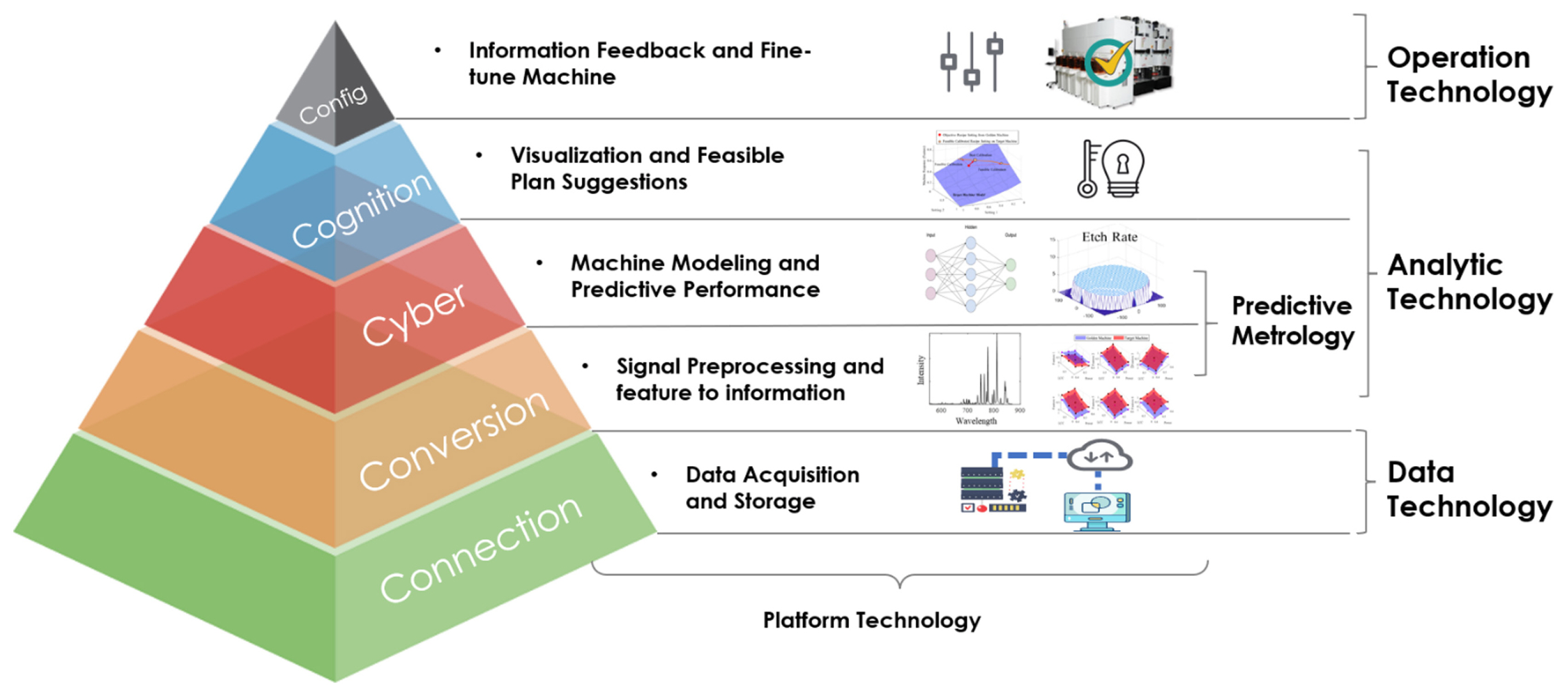
Fig.┬Ā2
Predictive metrology terminology chart inside 5-level CPS architecture 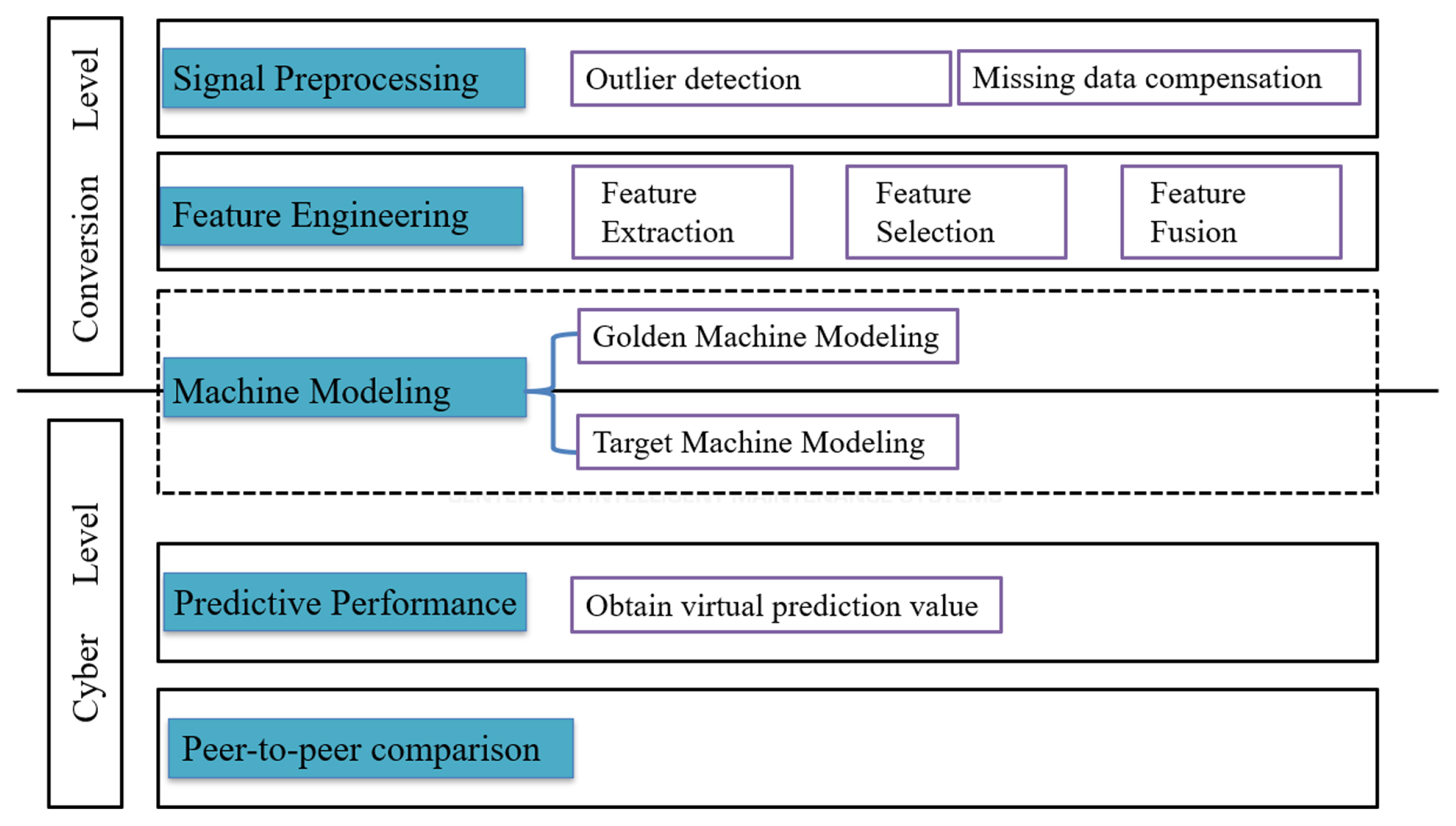
Fig.┬Ā3
The flowchart of the case study 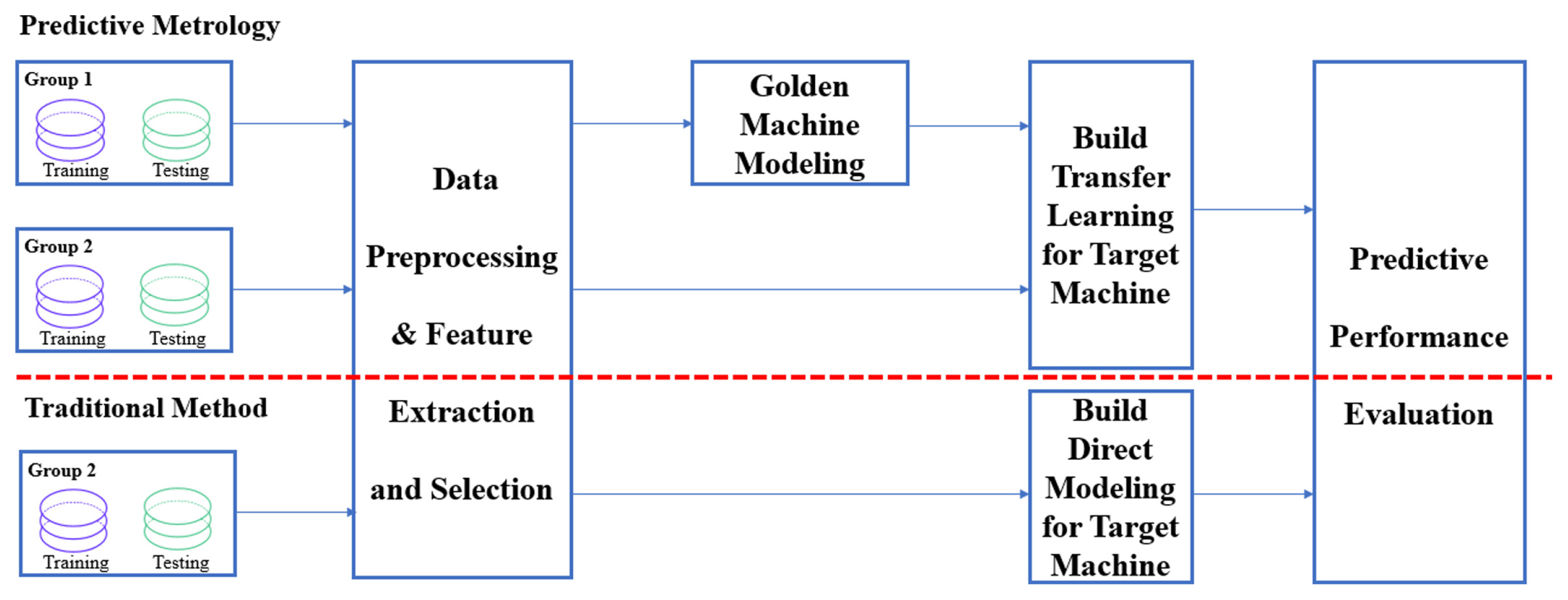
Fig.┬Ā4
Fully connected neural network for prediction 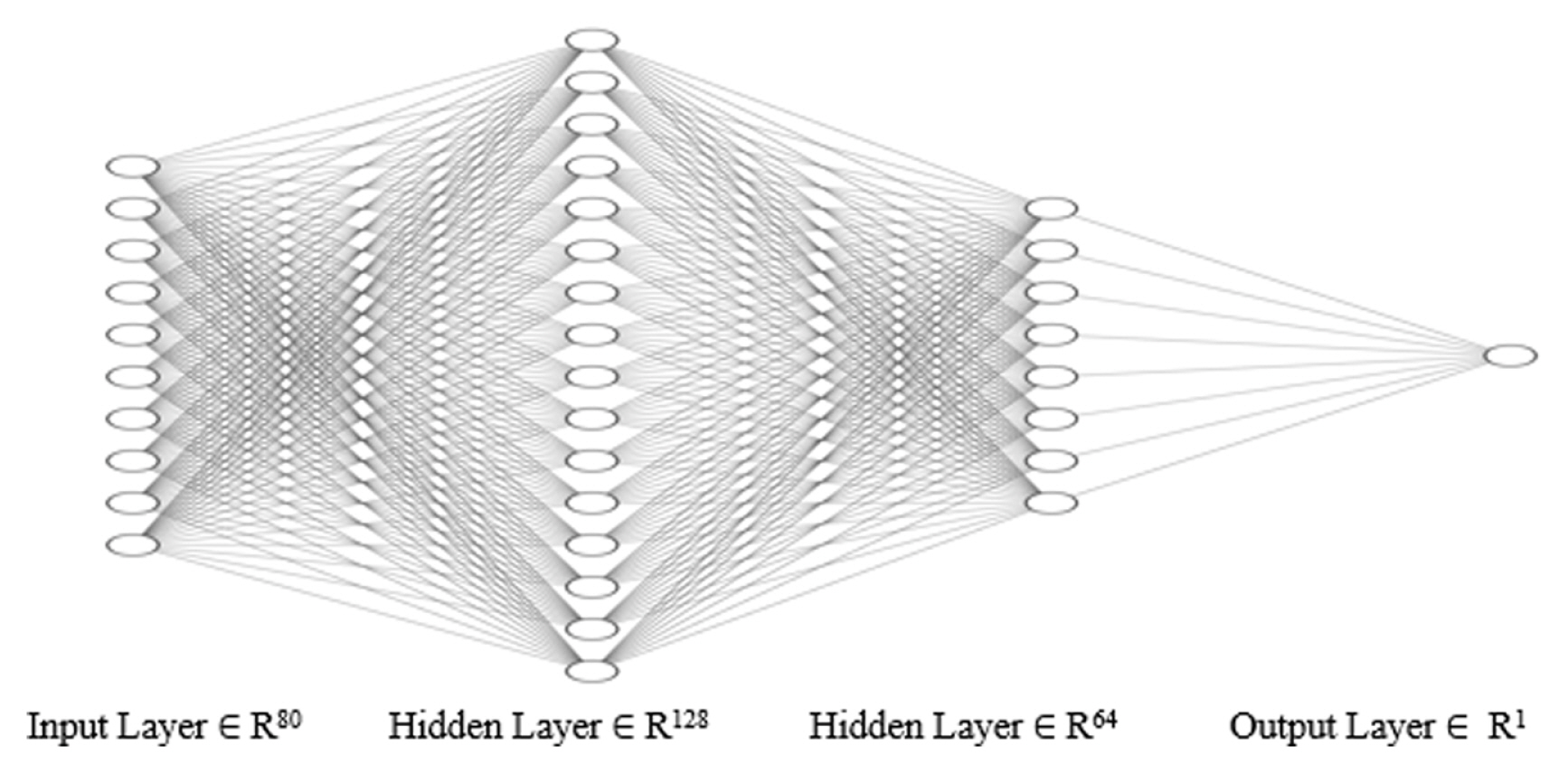
Fig.┬Ā5
Regression plot of predicted MRR versus true label based on the traditional method 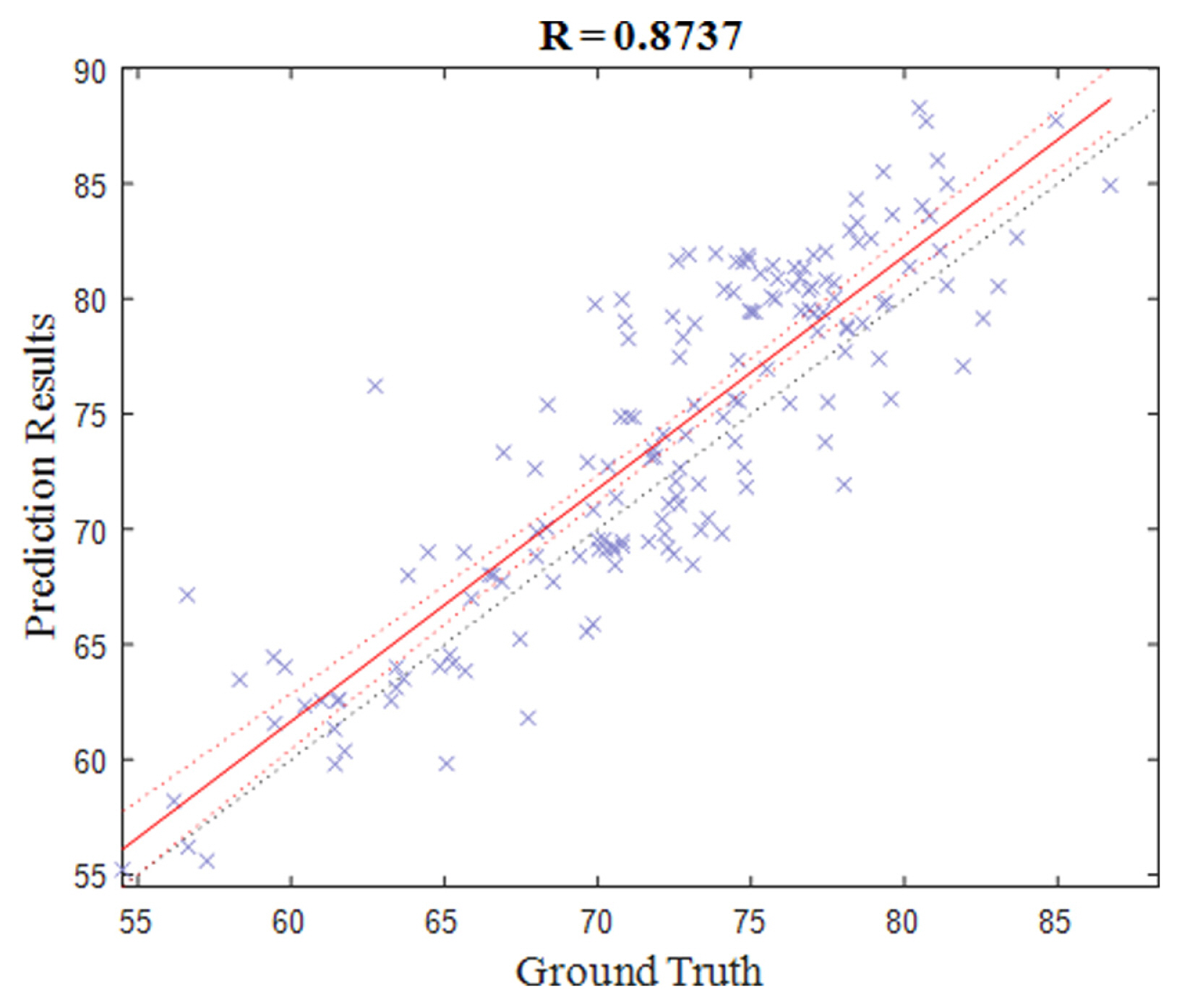
Fig.┬Ā6
Regression plot of predicted MRR versus true label based on the predictive metrology method 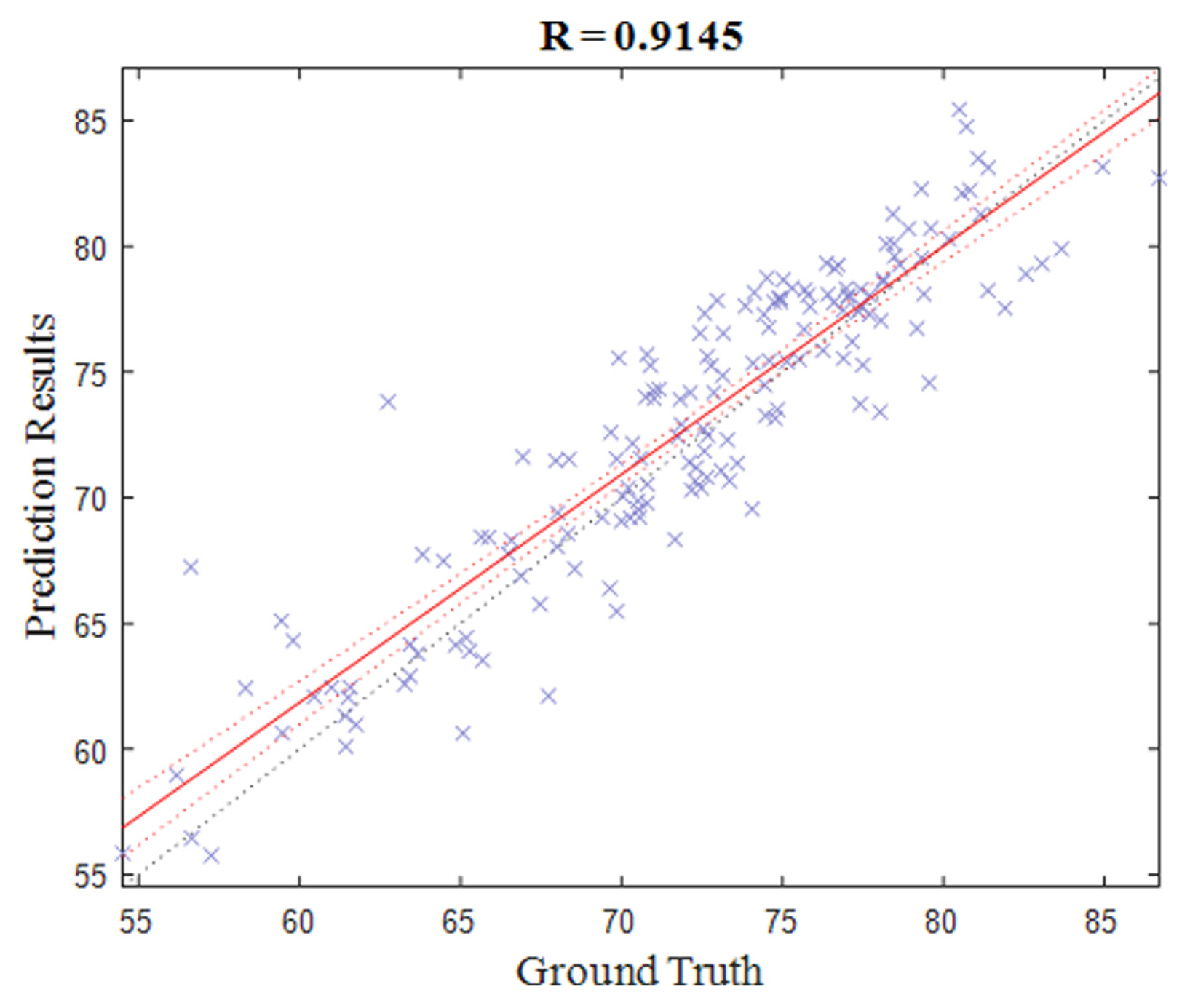
Table┬Ā1
PHM data challenge 2016 description
|
Stage |
Sample size |
Label range |
|
Training |
Testing |
|
Group 1 |
B |
815 |
186 |
50ŌĆō110 |
|
Group 2 |
A |
300 |
165 |
50ŌĆō110 |
Table┬Ā2
Experiment results comparison between traditional method and predictive metrology method
|
Method |
R |
MSE |
|
Golden machine (Group 1) |
Target machine (Group 2) |
Golden machine (Group 1) |
Target machine (Group 2) |
|
Traditional method |
|
0.8737 |
|
16.23 |
|
Predictive metrology method |
0.9256 |
0.9145 |
10.625 |
7.52 |
References
1. Moyne, J., Yedatore, M.Iskandar, J.Hawkins, P. & Scoville, J. (2014). Chamber matching across multiple dimensions utilizing predictive maintenance, equipment health monitoring, virtual metrology and run-to-run control. In: 25th Annual SEMI Advanced Semiconductor Manufacturing Conference (ASMC 2014); pp 86ŌĆō91.  2. Psarommatis, F., May, G., Dreyfus, P.-A. & Kiritsis, D. (2020). Zero defect manufacturing: State-of-the-art review, shortcomings and future directions in research. International Journal of Production Research, 58(1), 1ŌĆō17.  3. Chouichi, A., Blue, J.Yugma, C. & Pasqualini, F. (2018). The detection and the control of machine/chamber mismatching in semiconductor manufacturing. In: 2018 Winter Simulation Conference (WSC); pp 3583ŌĆō3591.  4. Chouichi, A., Blue, J., Yugma, C. & Pasqualini, F. (2020). Chamber-to-chamber discrepancy detection in semiconductor manufacturing. IEEE Transactions on Semiconductor Manufacturing, 33(1), 86ŌĆō95).
https://doi.org/10.1109/TSM.2020.2965288
.  5. Dreyfus, P.-A., Psarommatis, F., May, G. & Kiritsis, D. (2022). Virtual metrology as an approach for product quality estimation in Industry 4.0: A systematic review and integrative conceptual framework. International Journal of Production Research, 60(2), 742ŌĆō765.  6. Kanarik, K. J., (2020). Inside the mysterious world of plasma: A process engineerŌĆÖs perspective. Journal of Vacuum Science & Technology A: Vacuum, Surfaces, and Films, 38(3), 031004.  7. Lee, J., Bagheri, B. & Kao, H.-A. (2015). A cyber-physical systems architecture for industry 4.0-based manufacturing systems. Manufacturing Letters, 3, 18ŌĆō23.  8. Lee, J., Ardakani, H. D., Yang, S. & Bagheri, B. (2015). Industrial big data analytics and cyber-physical systems for future maintenance & service innovation. Procedia CIRP, 38, 3ŌĆō7).
https://doi.org/10.1016/j.procir.2015.08.026
.  9. Mishra, P., Biancolillo, A., Roger, J. M., Marini, F. & Rutledge, D. N. (2020). New data preprocessing trends based on ensemble of multiple preprocessing techniques. TrAC Trends in Analytical Chemistry, 132, 116045.
https://doi.org/10.1016/j.trac.2020.116045
.  10. Hou, B., Wang, D., Wang, Y., Yan, T., Peng, Z. & Tsui, K.-L. (2021). Adaptive weighted signal preprocessing technique for machine health monitoring. IEEE Transactions on Instrumentation and Measurement, 70, 1ŌĆō11).
https://doi.org/10.1109/TIM.2020.3033471
.   11. Santos, T., Schrunner, S., Geiger, B. C., Pfeiler, O., Zernig, A., Kaestner, A. & Kern, R. (2019). Feature extraction from analog wafermaps: A comparison of classical image processing and a deep generative model. IEEE Transactions on Semiconductor Manufacturing, 32(2), 190ŌĆō198).
https://doi.org/10.1109/TSM.2019.2911061
.  12. Zheng, Y., Vanderbeek, B.Daniel, E.Stambolian, D.Maguire, M.Brainard, D. & Gee, J. (2013). An automated drusen detection system for classifying age-related macular degeneration with color fundus photographs. In: 2013 IEEE 10th International Symposium on Biomedical Imaging; pp 1448ŌĆō1451.  13. Kim, D., & Kang, S. (2019). Effect of irrelevant variables on faulty wafer detection in semiconductor manufacturing. Energies, 12(13), 2530.  14. Ladha, L., & Deepa, T. (2011). Feature selection methods and algorithms. International Journal on Computer Science and Engineering, 3(5), 1787ŌĆō1797.
15. Blitzer, J., McDonald, R. & Pereira, F. (2006). Domain adaptation with structural correspondence learning. In: Proceedings of the 2006 Conference on Empirical Methods in Natural Language Processing; pp 120ŌĆō128.  16. Cateni, S., Vannucci, M., Vannocci, M. & Colla, V. (2012). Variable selection and feature extraction through artificial intelligence techniques. Multivariate Analysis in Management, Engineering and the Science, 6, 103ŌĆō118.  17. Tilouche, S., Bassetto, S. & Nia, V. P. (2014). Classification algorithms for virtual metrology. In: 2014 IEEE International Conference on Management of Innovation and Technology; pp 495ŌĆō499.  18. Kang, S., & Kang, P. (2017). An intelligent virtual metrology system with adaptive update for semiconductor manufacturing. Journal of Process Control, 52, 66ŌĆō74.  19. Lee, J., Azamfar, M., Singh, J. & Siahpour, S. (2020). Integration of digital twin and deep learning in cyber-physical systems: Towards smart manufacturing. IET Collaborative Intelligent Manufacturing, 2(1), 34ŌĆō36.   20. Jia, X., Di, Y., Feng, J., Yang, Q., Dai, H. & Lee, J. (2018). Adaptive virtual metrology for semiconductor chemical mechanical planarization process using GMDH-type polynomial neural networks. Journal of Process Control, 62, 44ŌĆō54. 
Biography
Dr. Jay Lee is Ohio Eminent Scholar, L.W. Scott Alter Chair, and University. Distinguished Professor, and founding director of National Science Foundation (NSF) Industry/University Cooperative Research Center (I/UCRC) on Intelligent Maintenance Systems ( www.im-scenter.net) in partnership with over 100 global company members. IMS was selected as the most economically impactful I/UCRC in the NSF Economic Impact Study Report in 2012. He is also the Founding Director of Industrial AI Center ( www.iaicenter.com). He mentored his students and developed a number of start-up companies including Predictronics through NSF iCorp in 2013. He was on leave from UC to serve as vice chairman and board member for foxconn technology group during 2019ŌĆō2021 to lead the development of foxconn wisconsin science park (~$1B investment) in Mt. Pleasant, WI ( www.foxconnwiofficial.com). In addition, he advised foxconn business units to successfully receive five WEF lighthouse factory awards since 2019.
Biography
Huwei Dong received his B.S. and B.Eng. degree in Mechanical Engineering from the University of Cincinnati, Cincinnati, OH, USA, in 2022 and Chongqing University, Chongqing, China, in 2022, respectively. He is currently pursuing the Ph.D. degree in Mechanical Engineering with the University of Cincinnati, Cincinnati, OH, USA. His research interests include prognostics and health management, data mining and machine learning.
Biography
Dai-Yan Ji received his B.S. degree in Electronic Engineering and M.S. degree in Communications Engineering from Feng Chia University, Taiwan, in 2009 and 2012, respectively. He is currently pursuing the Ph.D. degree in Mechanical Engineering with the University of Cincinnati, Cincinnati, OH, USA. He was a Research Associate in National Central University, Taiwan, in 2017. His research interests include machine learning, and prognostics and health management.
Biography
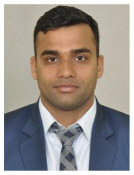
Pradeep Kundu is a Postdoctoral Fellow at the IMS Center, University of Cincinnati. Before joining IMS, he worked as a research associate from Dec. 2020 to Jan. 2022 on an EPSRC-funded project titled ŌĆ£A Multiscale Digital Twin-Driven Smart Manufacturing System for High Value-Added ProductsŌĆØ at the University of Strathclyde, U.K. Pradeep completed his Ph.D. study in 2020 in the specialization of prognosis and health management from the Department of Mechanical Engineering at the Indian Institute of Technology (IIT) Delhi, India. In 2019, he received a visiting research fellow grant from SERB, Govt. of India, to carry out his Ph.D. research work at the University of Alberta, Canada. Pradeep has published more than 25 articles in reputed academic journals and conferences such as mechanical systems and signal processing, journal of intelligent manufacturing, structural health monitoring, etc. His research interests are industrial artificial intelligence, cyber-physical systems, digital twins and smart manufacturing, fault diagnosis and prognosis and reliability engineering.
|
|
| TOOLS |
|
|
|
|
|
|
|
|
|
|
|
|
|
|
METRICS

|
|
|
|
|
|



 E-mail
E-mail Print
Print facebook
facebook twitter
twitter Linkedin
Linkedin google+
google+






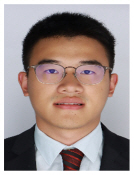


 PDF Links
PDF Links PubReader
PubReader Full text via DOI
Full text via DOI Download Citation
Download Citation  CrossRef TDM
CrossRef TDM



